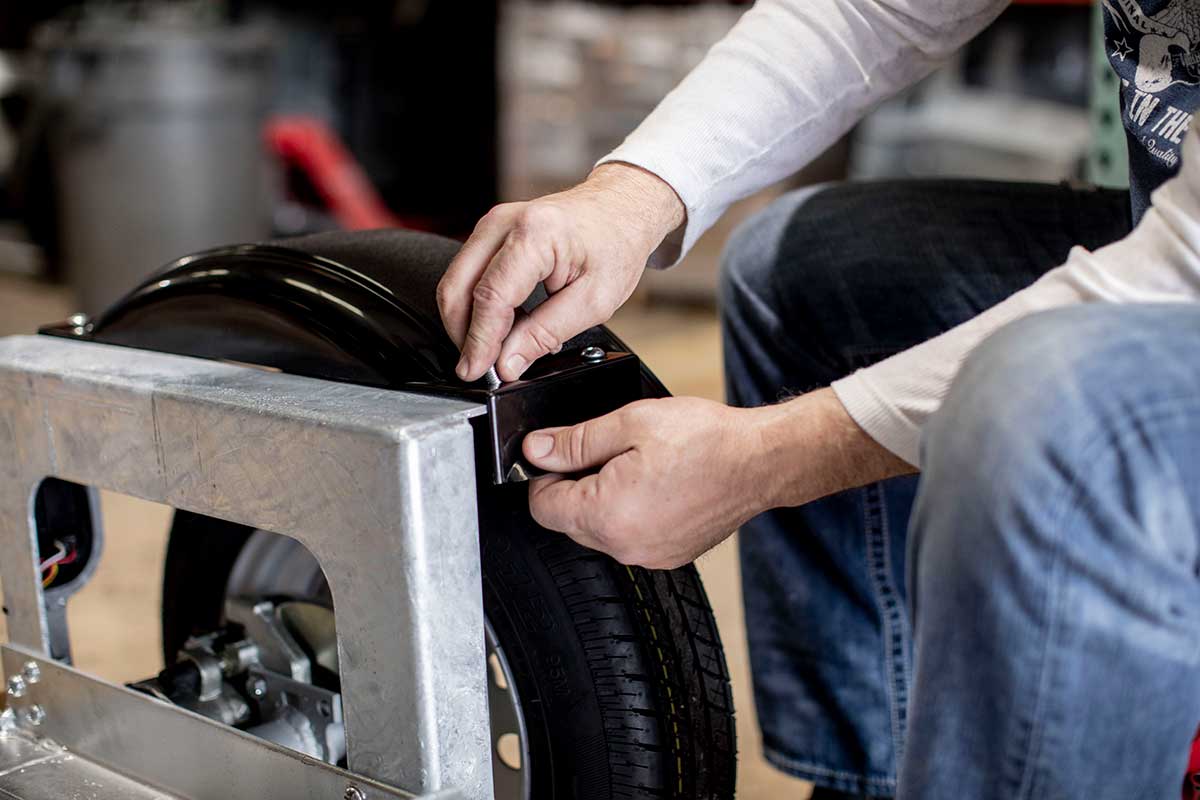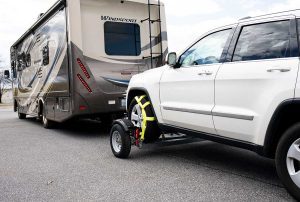
Tow Dolly Brakes: Are They Required?
Heading across the country in your RV with a vehicle-in-tow is a popular pastime for millions of Americans. This is done with the help of a tow dolly, which is easy to install and even easier to load a vehicle onto with the help of just one other person. If you’ve never owned a tow dolly and are planning a cross-country trip, there’s plenty of information you should know before heading out on the open road, including if you need tow dolly brakes.
How to Become Compliant
In order to become compliant when driving with a tow dolly, you will need a dolly with brakes. This is true for all 50 states, the District of Columbia, and even Canada. You can’t forget that many RV-goers love to travel to Canada, and they may or may not have the same laws as the United States when it comes to using a tow dolly on the road.
If you are going to tow anything at or over 3,000 GVWR, you will be required to have brakes on your tow dolly in all 50 states, the District of Columbia, and Canada. This is important to note, especially if you wind up purchasing a used tow dolly from a friend or family member. Make sure you ask whoever is selling the tow dolly if it has brakes.
What is a Breakaway System?
Many, not all states require a breakaway system along with tow dollies with brakes. A breakaway system is an additional piece of equipment that can be deployed to stop the dolly should it come disconnected from your vehicle. This means that the brakes will be deployed on the tow dolly without your assistance or the assistance of whoever is driving the vehicle that is doing the towing. This is an added safety feature that can be installed even if you live in a state where it’s not required.
State-by-State Car Dolly Brakes Requirements
Below, you will find a list that outlines the requirements for tow dollies with surge brakes:
Alabama
Over 3,000-pounds: an independent braking system must be installed.
Alaska
Over 5,000-pounds: an independent braking system must be installed and the breakaway system is also required.
Arizona
Over 3,000-pounds: an independent braking system must be installed.
Arkansas
Over 3,000-pounds: a breakaway system and an independent braking system must be installed.
California
Any trailer that weighs more than 1,500 pounds must have bakes and a breakaway system.
Colorado
Over 3,000-pounds: an independent braking system must be installed along with a breakaway system.
Connecticut
Trailers weighing more than 3,000 pounds require brakes. Any trailer weighing more than 10,000 pounds must have a breakaway system installed.
Delaware
Over 4,000-pounds: an independent braking system must be installed along with two different means of applying brakes.
District of Columbia
Brakes must be installed on every wheel of a trailer unless it weighs less than 3,000 pounds.
Trailers weighing more than 3,000 pounds must have brakes on all wheels that can be applied automatically and remain applied for 15 minutes after breaking away from the vehicle doing the towing.
The person in the driver’s seat must also have access to a manually controlled braking device.
Florida
Trailers over 3,000-pounds must have brakes as well as two different ways of applying trailer brakes when a vehicle with air brakes is being towed.
Georgia
Brakes must be installed on all wheels of every trailer weighing 3,000-pounds or more.
Hawaii
For trailers weighing 3,000-pounds or more: an independent braking system must be installed
Idaho
For trailers weighing 1,500-pounds or more: an independent braking system must be installed along with a breakaway system.
Illinois
For trailers weighing 3,000-pounds or more: an independent braking system must be installed along with a breakaway system.
Indiana
Brakes must be installed for a trailer that weighs 3,000-pounds or more along with a breakaway system.
Iowa
A trailer weighing 3,000-pounds or more must have an independent braking system that must be installed and a breakaway system.
Kansas
Any combination of vehicles must be able to come to a stop within 40 feet while traveling at 20 MPH.
Kentucky
There is no law that requires tow dollies with brakes for any passenger car trailers no matter the weight.
Louisiana
A trailer that weighs more than 3,000-pounds: an independent braking system must be installed along with a breakaway system.
Maine
A trailer with a gross weight of 3,000 lb. must have brakes.
Maryland
Brakes must be installed on all wheels of trailers weighing 3,000-pounds or more along with a breakaway system.
Massachusetts
A trailer that weighs more than 10,000-pounds when empty must have electric or air brakes installed.
Michigan
If a trailer weighs more than 15,000-pounds it requires an independent braking system.
Minnesota
If a trailer weighs more than 3,000-pounds it must have brakes. If a trailer weighs more than 6,000-pounds it must have a breakaway system.
Mississippi
Trailers weighing more than 2,000-pounds must have an independent braking system and a breakaway system installed.
Montana
Trailers weighing more than 3,000-pounds must have an independent braking system and breakaway system installed.
Nebraska
All trailers weighing more than 3,000-pounds but less than 6,500-pounds must have brakes installed on two wheels. Trailers weighing more than 6,500-pounds must have brakes installed on every wheel. These trailers must also have a breakaway system or tow dollies with surge brakes installed.
Nevada
Brakes must be installed on all trailers weighing more than 1,500-pounds. Trailers weighing 3,000-pounds or more must have brakes and a breakaway system installed.
New Hampshire
Trailers weighing more than 3,000-pounds must have brakes. All vehicle combinations are required to stop within 30 feet when traveling at 20 MPH.
New Jersey
Trailers weighing more than 3,000-pounds must have brakes and a breakaway system installed.
New Mexico
Brakes are required for trailers weighing more than 3,000-pounds.
New York
Any trailer with a gross weight of 1,000-pounds or more must have brakes installed.
North Carolina
Any trailer that weighs 1,000-pounds or more must have brakes.
North Dakota
Any trailer that is operated at 25 MPH or more must have safety chains and brakes installed.
Ohio
A trailer with an empty weight of 3,000-pounds or more requires brakes.
Oklahoma
A trailer with a gross weight of 3,000-pounds or more is required to have brakes.
Oregon
Oregon does not require an independent braking system. Instead, all vehicle combinations are required to stop within the legal limits.
Pennsylvania
Trailers weighing 3,000-pounds or more must have an independent braking system and a breakaway system installed.
Rhode Island
Any trailer that weighs more than 4,000-pounds is required to have an independent braking system as well as a breakaway system.
South Carolina
Trailers weighing more than 3,000-pounds must have an independent braking system and a breakaway system installed.
South Dakota
If your trailer weighs more than 3,000-pounds it must have brakes. The breakaway system is only necessary when you are towing vehicle combinations of two or more.
Tennessee
Every trailer weighing 3,000-pounds or more must have brakes installed that can be stopped by the driver of the towing vehicle. The trailer must also have a breakaway system.
Texas
Any trailer that weighs more than 4,500-pounds must have brakes.
Utah
All vehicles and vehicle combinations must have a braking system that stops the vehicle within 40 feet while traveling at 20 MPH as well as a parking brake system.
Vermont
Any trailer weighing more than 3,000-pounds must have an independent braking system along with a breakaway system.
Virginia
Any trailer that weighs 3,000-pounds or more must have an independent braking system installed.
Washington
Any trailer that weighs more than 3,000-pounds is required to have an independent braking system installed.
West Virginia
An independent braking system must be installed on trailers with a gross weight of more than 3,000-pounds and a breakaway system.
Wisconsin
A trailer or any other towed vehicle that weighs more than 3,000-pounds must have an independent braking system installed.
Wyoming
An independent braking system is required for any vehicle combination so that it can stop within 40 feet while traveling at 20 MPH on a dry, level, smooth, hard surface along with a parking brake system.
Buy Car Dolly Brakes Today
If your tow dolly does not have the proper brakes needed to be street legal, it’s time to visit Car Tow Dolly to purchase car dolly brakes or tow dollies with surge brakes today. Contact us to speak with an experienced member of our team or visit us online to purchase tow dollies with surge brakes. A car tow dolly bundle is an excellent option for vehicle owners who need to tow a vehicle across the country. The bundle comes with every item you will need instead of having to purchase all of them separately.


